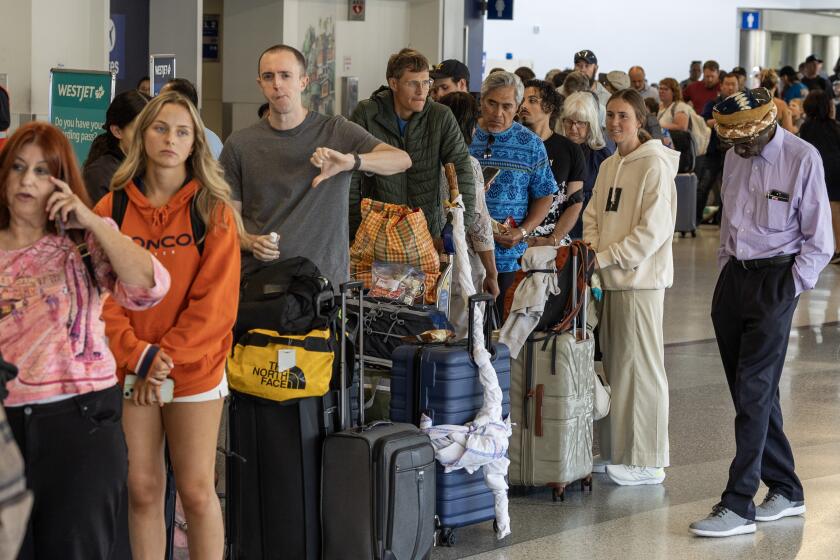L.B. Panel Offers Plan for Minority Recruitment
Responding to minority group criticism of the city’s employment and promotion practices, the Long Beach Civil Service Commission Wednesday recommended hiring two full-time recruiters to increase the number of minority applicants for municipal jobs.
The commission also said community leaders should participate in the recruitment program, and added that city departments should find a way to inform civic organizations about applicants who fail to be hired as well as those who become employees.
The recruitment plan will be forwarded to the City Council, which requested the recommendations after Long Beach failed to meet its 1983-84 goals for hiring women, Latinos, Asians or Native Americans.
Civil Service Commission Executive Director Carol Moss said the council could act as soon as next week on the recruitment proposal.
As in years past, the annual affirmative action report, released in October, said the city government made “measurable progress” last year but also noted a continuing “significant deficiency” of Latinos--the most under-represented ethnic group among the city’s 4,000 employees.
Latinos, who make up 22.1% of the local labor pool, were 6.8% of the municipal work force in 1983. The city set a goal of 10% by June 30, 1984, but by that date, only 7.1% of city workers were Latino. The 1984-85 goal set in the report was 10.6%.
Priority Recruitment
The affirmative action report recommended priority recruitment of Latinos in all job categories for all 22 city departments. The report also urged priority recruitment of women for all openings except clerical and paraprofessional positions. An analysis of municipal job applicants found that the “flow may be sufficient to meet the 1984-85 . . . goals for females, but not for Hispanics,” according to the report.
Women were 24.7% of city employees in 1983 and currently hold 24.9% of city jobs. The goal for 1983-84, however, was 29% and the goal set for this year is 29.1%. Women are 42.8% of the local labor market, the report said.
Blacks, who constitute 8.8% of the available labor market, make up 17.1% of the full-time city work force, but they are concentrated in blue-collar jobs, the report said. Also, there are few blacks in the highly visible Police Department (which is 82% white) and Fire Department (which is 92.5% white), NAACP leaders have noted.
Mounting anger among minority group activists has made the affirmative action issue a visible one. Complaints from the League of United Latin American Citizens (LULAC) spurred a federal threat in July that $6 million a year in revenue-sharing funds would be cut off unless more Latinos are hired by the city’s Recreation Department. The city agreed to increase the number of Latinos in that department according to a timetable negotiated with the U.S. Office of Revenue Sharing.
Criticism from LULAC, the Centro de la Raza/East Long Beach Neighborhood Center and the National Assn. for the Advancement of Colored People prompted a Public Safety Advisory Commission review of minority recruitment for the mostly white police and fire departments.
In November, a group of black leaders publicly proposed a boycott of downtown businesses to force the city to step up hiring and promotion of minorities, although they later decided not to begin their campaign because they believed the city government was beginning to step up its efforts to increase minority employment.
The City Council’s personnel committee held hearings in December to review affirmative action goals.
The Civil Service Commission developed its recruitment plan after hearing testimony from representatives of civic organizations including the Long Beach branches of the NAACP, LULAC, and the National Organization for Women.
The suggestion to inform community groups about minority applicants who are not hired as well as those who are, came from Frank Berry, president of the local chapter of the NAACP.
“We want to be able to specifically identify problems that people have when they attempt to be employed by the city,” Berry said.
At Wednesday’s meeting, commission member Aaron Herrington added that such information should be provided “until we satisfy the public in general that there is no bias” in the city’s employment process.
“They don’t believe us now,” Herrington said.
However, Moss said, the Civil Service Department is not told why individual applicants are not hired. Each department makes its own final selection of employees from a civil service list and therefore they would have to be the source of the information, she said.
The commission also proposed telling schools about any changes in minimum requirements for city positions, providing career information to students as early as junior high school and arranging tours of city facilities for minority organizations and prospective minority applicants.
City Manager John Dever has cited budgetary constraints as one reason the city had not increased the number of its employees, which would allow more minorities to be hired. He also has said finances had prevented increasing the recruiting staff in the past. Currently there are no full-time recruiters of minorities and women.
Moss said she does not yet know how much the proposed recruitment program would cost.
“I’m working on that now,” she said.
The commission expects to report to the council on other aspects of the hiring process by March 19, Moss said.
More to Read
Sign up for Essential California
The most important California stories and recommendations in your inbox every morning.
You may occasionally receive promotional content from the Los Angeles Times.






